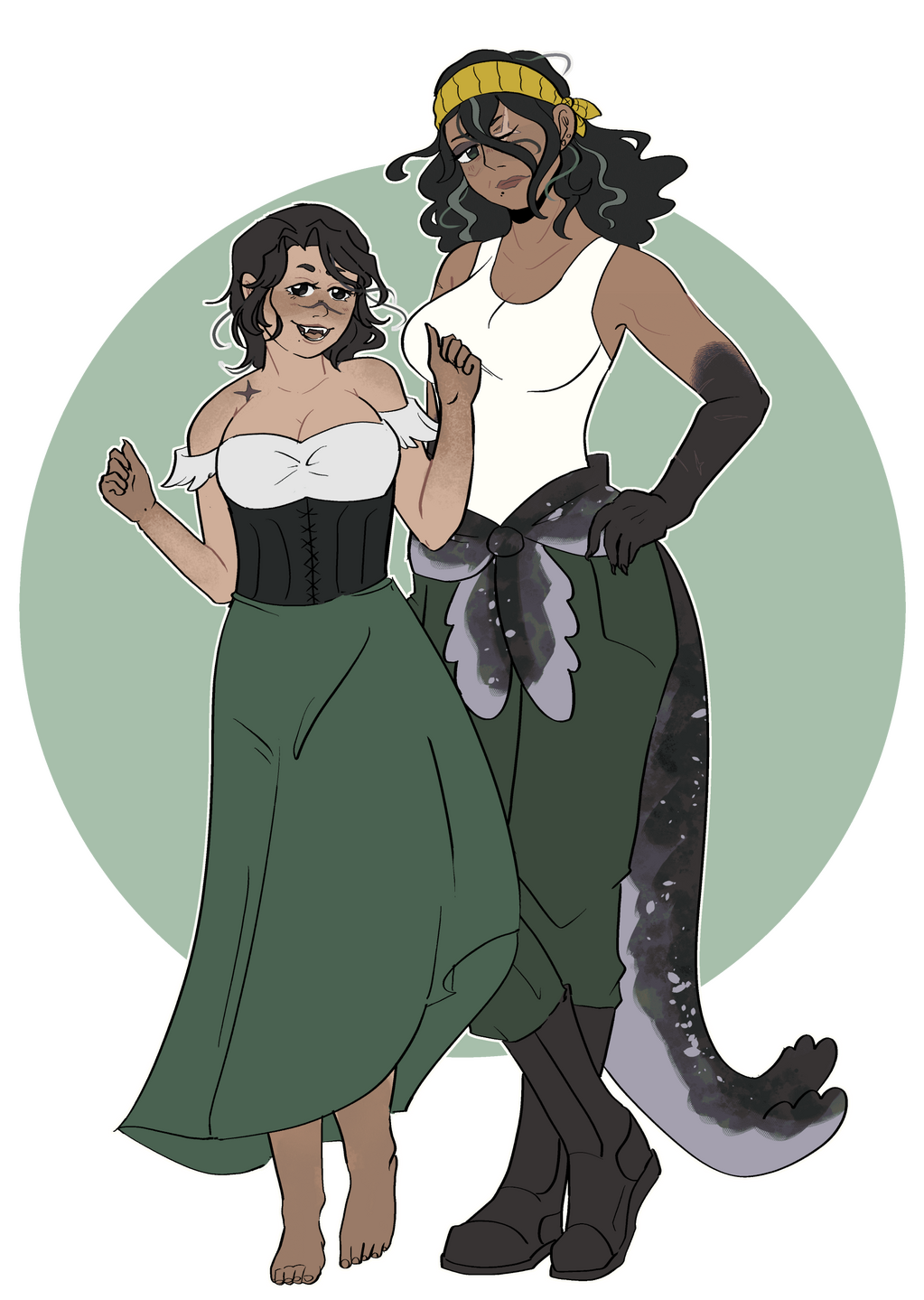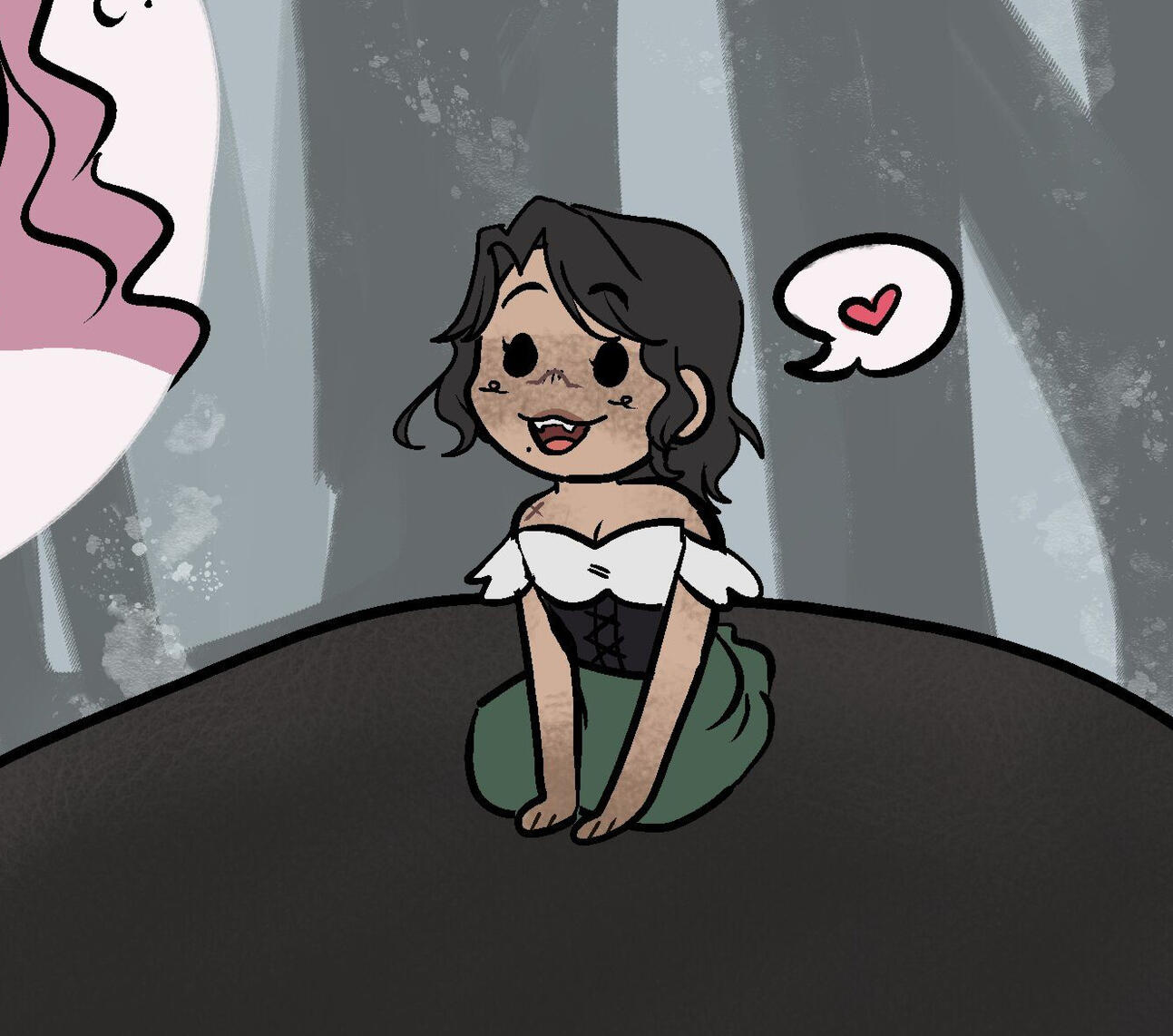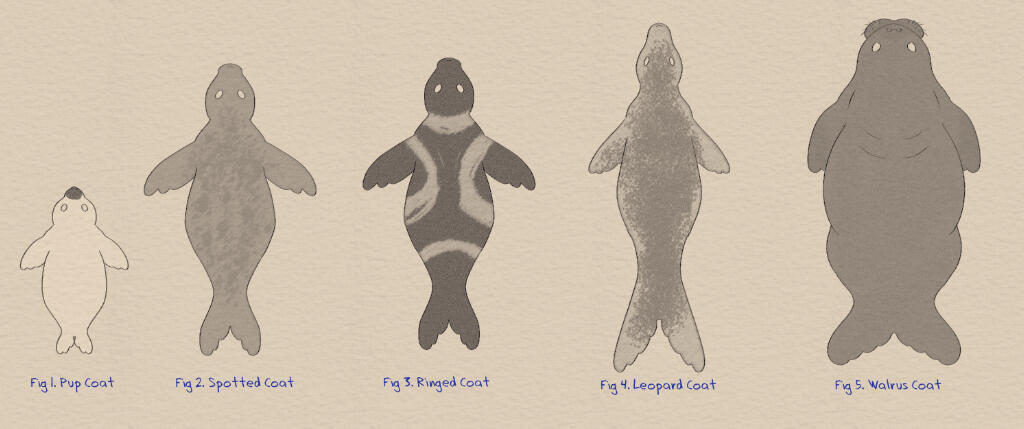LaikasLastStand presents...
The Selkie: A One Piece Fan Race
Hi Hi! Welcome to my kitchen. I made this lore to have fun with my friends! Please feel free to use and expand on it however you like! If you do use it, it'd be cool if you could maybe tag me so I could see!! Lets make seals together!

Selkie Biology
The selkie tribe are generally humanoid in nature, with the ability to don a sealskin coat that converts them into a seal. Their 'coatless' forms, however, maintain some animalistic features. They posses claws and seal fangs even in their humanoid forms, their extremities tend to be more melanated, creating a gradient from hands/feet to mid arm/kee. Their skin has a velvety texture.Selkie eyes are often dark colored- deep blues, browns, or greens. Their eyes have a reflective quality.Members of the selkie tribe have a thicker fat distribution and don't often feel cold. However, due to this they do not fare well in hot weather and require frequent swimming breaks during summer months.Selkie have an innate connection to the phenomenon known as "The Voice of All Things". The selkie tribe are also able to breathe under water, and have an ability to pass this breath temporarily to a non water breathing creature by blowing air into their lungs. This is typically seen as a "kiss". Furthermore, Selkie are natural born navigators.Selkie coats are intrinsically linked to the selkie who owns it. Every selkie is born in their coat, which starts as a membrane protecting the newborn before forming into the plush, beautiful coat they are known for within the first few years. When a selkie dies, even if the coat is not on their person, the coat will crumble into a "seafoam" like substance. Selkie have a deep psychological link to their coat, and will often submit themselves to whomever possesses their coat, though their nomadic nature will often find them attempting to steal it back. If physically separated from their coat for too long, the selkie becomes ill, their organs starting to slow. Selkie coats have a healing property to them, with a selkie recovering from minor wounds and sickness faster when in their coat. Their coat is an extension of their body, and it is thought that contact with the skin of the coat stimulates the circulatory and immune system.
Selkie coats come in many shapes, sizes, and colors. There are no two that are exactly alike. There are as many sub-species of selkie as there are seal equivalents. While the shown graphic shows a sampling of different coats, there are any number of possibilities!
Selkie Life Cycle
Selkie mature 3x slower than their human counterparts. Their typical natural life span is between 300-350 years, though predation often cuts this short.In general, here is a breakdown of a selkies life during those years. Bold will be the actual year, and human equivalent notates the equivalent to human maturity.0-6 yrs (human equivalent 0-3): Selkie are born with a fleshy membrane covering them. They will continue to grow in this membrane for the next several months before it begins to separate. The membrane, which will eventually become their coat, starts to grow a plush white fur that keeps the pup warm. After a year, the pup can remove the coat for short periods, but their bodies are very sensitive and still require the coat to keep them safe.7-18 yrs (human equivalent 3½-6): The pup's coat is shedding it's white fur and developing it's unique patterns. It is beginning to develop a curious personality and swimming away from it's mother to other members of it's pod. This is the peak period selkie hunters look for when ambushing and stealing a selkie, making it a very critical period in the pups life.19-51 yrs (human equivalent 6½-17): This period of puphood to adolescence is characterized with the pup growing bolder. They have learned to hunt and fight a bit on their own. They still live within their pod, but are starting to venture further from the group. While they have not reached mental maturity, they are beginning to explore boundaries and act more independently in the safety of their group. Older selkie will still guide them or give corrections if needed, ensuring the young selkie is prepared for their next stage of life.52-105 yrs (human equivalent 17½-35): The selkie has reached maturity and outgrown its pod. At this point in it's life, the young selkie will leave it's pod and venture to the world. Often, young selkie will go to human towns to sate curiosity or to find a mate; selkie often interbreed with other races. Their offspring have a 75% chance of being born with selkie biology, but will carry the genes regardless. If a selkie pup is born this way, the parent selkie will ofttimes steal them back to the sea, regardless if the other parent approves or not.106-240 yrs (human equivalent 35½-80): A selkies adulthood can be spent several ways. Some choose to stay in towns or live on their own/with small families. Others choose to return to pods, or make their own. How a selkie chooses to live out it's prime depends on the individual's personality.241-300+ yrs (human equivalent 80½-100+): In the twilight of a selkies life, they seek out water. More solitary selkie will stay near a beach, others will return to the sea. In pod communities, older selkie are taken care of by the younger ones and in turn impart the wisdom of their years and pass on stories. Natural end of life for selkie is a peaceful affair. Their life is celebrated and remembered by their pod. When a solitary selkie senses its passing is near, it will go to the sea and allow the water to take it.Due to the many threats to a selkie pup, selkie have evolved to not show much that they are pregnant. There is not much noticeable change in outward appearance until a few days before delivery. However, other selkie or beast-kin race can smell the hormonal difference and will flock to the individual to guard them carefully for the duration of gestation.
Threats to Selkie-Kind
The oldest threat to selkie-kind are Sea Kings, the latter being a selkies only natural predator. Living in pods give selkie a greater advantage of outfighting the large sea monsters, but it is not uncommon for Sea Kings to pick off smaller, weaker selkie before they are driven away.Land dwelling races became a major threat to selkie-kind as the two began to mingle more. The curious, trusting selkie were easily ambushed for their coats, which were sought for their warmth, beauty, and durability.Land races and selkie-kind had a tense relationship, with land races viewing the sea-dwelling race as animals until several centuries later (much like other beastkin races).Many selkie were kidnapped and held prisoner so their keepers could wear their coats. In the era of sea-faring, it became a common practice for sailors to kidnap a selkie for use of their navigational prowess and ability to sense storms. During this time, a cruel practice known as clubbing became common place, wherein a cuff secured by a nail driven through the heel was fixed to a selkie's foot. This made walking painful and swimming near impossible, keeping the selkie dependent on their captor. This practice was more commonly enacted on older selkie. A "less cruel" method of ambushing and stealing a young selkie to groom into the position replaced it eventually.
Selkie Culture
The Selkie tribes were a nomadic culture. They existed in communities called "Pods" and traveled around the sea. They were a nonviolent folk who were known to be keepers of history and excellent story tellers.Selkie young were raised by the entire pod, ofttimes without them knowing who their true blood parents are. When reaching maturity, adolescent selkie often go to lands, hiding their coats and spending time in human townships. Interbreeding was extremely common and encouraged within selkie communities, though when a child was born with a coat, the parent would often bring them back to their home pod- oftimes without informing the other parent.When selkie grew older, they would return to the sea, sometimes returning to their home pods, other times joining new ones. They would bring with them new tales and history from the islands they visited.Selkie will sometimes gift their coat to their loved ones. It is not uncommon for selkie mates to wear eachothers coats, or for a selkie to lend their coat to a partner who is leaving on a journey. Though the distance from their coat leaves them physically weakened, this act of love is done willingly.
Naming Convention
Due to their nomadic nature, selkie draw from many different cultures! Therefor, it is common to find many different names within pods.Traditionally though, selkie were named for different aspects of and synonyms for tales and legends to show their role as history's story keepers.Some examples are: Saga, Ballad, Arc, Yarn, Stanza, Fable, Myth, Limerick.Many selkie are part of the D. clan.
History
In pre-seafaring history, Selkie coats were an extremely in demand product. Though the coats would not turn a different wearer into a seal, they were plush, warm, and waterproof- not to mention extremely beautiful. Many selkie were hunted and killed, only to discover their coat would die with them. Thus the first selkie capturing campaign would begin. These first imprisoned selkie were often treated as pets or zoo animals, typically locked away or otherwise abused. However it was soon found that they made excellent, obedient servants, so long as their owner had their coat.It would be several years later when traders would find use of their navigational skills, and soon it became common practice for a ship traveling great distances to capture a selkie and for the captain to keep their coat. This was often done by ambushing a pod and kidnapping a very young selkie, ensuring they could raise it to be tame and compliant.After some time, the peaceful selkie tribes began to attack the other races in turn, overturning fishing boats, drowning swimmers... A war of some sort between the land dwelling tribes and selkie went on for some time until the cruel capture of selkie was eventually banned kingdom by kingdom. In turn, young adult selkie in their wandering stage of life would ofttimes offer their coat to boating captains for a set amount of time, ensuring a mutually beneficial relationship wherein the selkie can travel wide distances, and the crew gain their navigational prowess. While selkie hunting became an extremely rare and looked down upon practice, many pirates still would kidnap selkies and take their coats, upholding the old tradition.Some time after the establishment of the world government, shortly after whats been known as the 'void century', the 5 elders declared selkie a highly dangerous race. The previously discussed 'war' was cited as the reason- however, it is speculated that the selkie tribes, story tellers by nature, were spreading information the world government wanted to bury. Whatever the reason, the hunting and extermination of the Selkie tribe was thereby ordered by the world government.Selkie are currently considered an extinct race. However, tales were told of selkie who escaped slaughter by being property of pirates, or perhaps of the government themselves taking a small portion prisoner. Some say that due to their ability to shed their seal-skin, they could be walking among the land-dwelling races even now. Whatever the case may be, selkie are if nothing else, extremely rare, and incredibly elusive..
Story Keepers
Stories are the life blood of the selkie species. They have very good memories. A selkie need only hear a story once for them to be able to pass it on. To some, this makes them incredibly dangerous.
The Selkie Princess: A Legend, A Hope
In a time long since forgotten, the selkie king Atlas had a daughter named Mirth. Mirth was the joy of the selkie kingdom, the embodiment of love. Her coat was white as snow, never losing it's pup fluff, and her eyes reflected the stars.One day, a friend to the selkie came to ask for her hand. He was called Joy Boy, and the Selkie Princess was in love. Their union brought joy to all their peoples, and they enjoyed many happy years.However, a war brewed around them. One day, a great villain stole the selkie Princess. This villain, a shadow upon the world, wanted Mirth to themself. They laid a trap for Joy Boy. When all seemed lost, Mirth managed to break free from her confines, and throw herself between the Shadow and her husband. The princess took a devastating blow. As she lay dying, she promised her coat to Joy Boy, vowing to return one day if he would only wait for her.Years pass, and the great shadow won their war. But selkie-kind remember their Princesses vow. One day she will return and stand at Joy Boy's side, and a New Dawn will banish the darkness from the world.
Thanks for looking!
Disclaimer: This is my take on selkies made to fit into the One Piece universe, specifically in an RP setting with my friend. While I was inspired by a lot of actual selkie lore from Celtic mythology, none of this should be taken as anything other than fan fiction.If you make a selkie based on this lore, please please PLEASe tag me, I want to see! You can find my socials below :3


